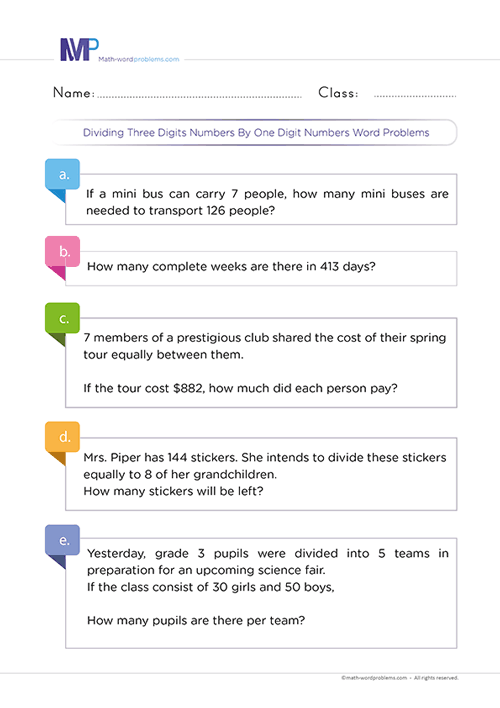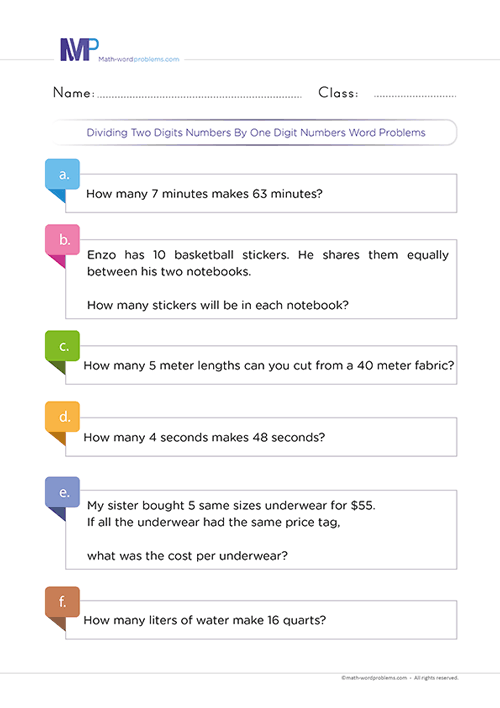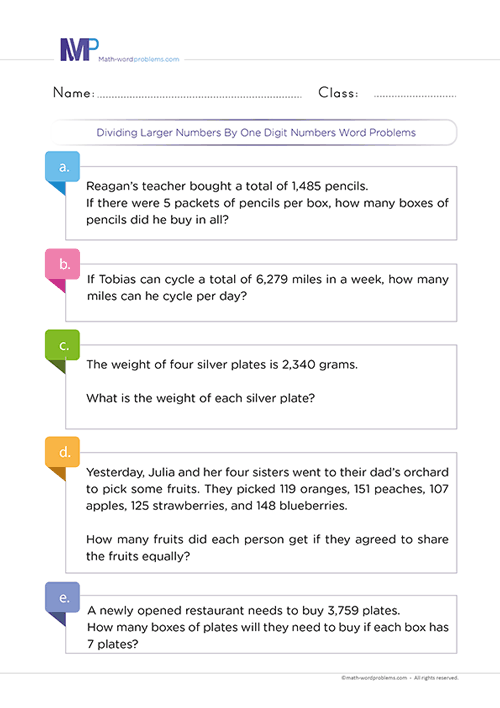 How do you divide three-digit numbers by one-digit number word problems?
How do you divide three-digit numbers by one-digit number word problems?

- INTRODUCTION
- Step 1 Identify
- Step 2 STRATEGIZE
- Step 3 SET UP
- Step 4 PROVIDE A SOLUTION
- Step 5 CHECK YOUR WORK
Get more contents on this skill...
How do you divide three-digit numbers by one-digit number word problem? Encourage your 3rd Graders to engage in this fantastic resource where they'll gain genuine skills and strategies for dividing three-digits by one-digit word problems.
These fun and straightforward strategies will significantly enhance your 3rd graders' logical reasoning and conceptual thinking skills beyond their expectations.
Steps on how to perform division of three-digit numbers by one-digit numbers word problems
The uniqueness of these steps on how to perform division of three digits numbers by one-digit numbers word problems will motivate kids to become exceptional maths word problem solvers.
This guide is so practical that after kids learn how to divide three-digit numbers by one-digit number word problems, they will gain a positive attitude each time they encounter complex division word problems.
However, we will provide thrilling real-world examples below to enable these young math learners to see how fantastic these steps work.
Step 1 IDENTIFY THE PROBLEM:
To identify the problem,
- You can start by reading out the problem carefully to understand it better.
- Then, identify and underline vital statements that are related.
- Now, reread the problem and try to figure out any important numbers and keywords in the problem.
That is, the keywords that you'll most likely encounter when you need to perform a division operation are: - divide, half, evenly, every, per, parts, out of, the quotient of, the ratio of, how many in each, equal parts, cut up, average, as much, etc.
Note: learners should understand that it would be best not to rely entirely on keywords alone because a particular keyword can have different meanings in different word problems.
In that case, you need to read the question very well to understand the situation the word problem describes. After reading, you will also find out if the problem makes sense first before determining which operation you need to use.
Step 2 STRATEGIZE AND DETERMINE THE OPERATIONS
In this step, ask yourself this pertinent question because it helps, "how am I going to handle this problem?"
Here, you must apply the read-to-understand rule. That is to say, you have to read the word problem and try to interpret it in your own words.
Furthermore, since each word problem may require a different solving format, the key points below will enable you to tackle any word problem irrespective of the format.
- First, the keyword(s) in the word problem will help clarify the operation you need to carry out.
- However, relying on keywords alone to solve word problems has some limits, as mentioned in step 1 above.
- So, you must first read the word problem to understand the situation that the problem is describing.
- Reading the problem to understand it will enable you to identify the problem type and relative statements in the word problem, which, together with the keyword(s) in the problem, will determine the correct maths operation that you need to use
Step 3 SET UP A NUMBER SENTENCE AND AN EQUATION
- Now, after knowing which operation you will perform from step 2 above, construct short sentences to represent the information given in the word problem.
- These short sentences represent the vital information that makes it easier to solve the word problem. In order words, it is like a diagram of the word problem.
- After that, you can now deduce a solvable maths equation to represent the information given in the sentences that you constructed above.
Step 4 SOLVE THE PROBLEM
After writing the maths equation, divide the values using either the short or the long division method. Also, include the unit of measurement in your final answer.
Step 5 VERIFY YOUR ANSWER
Finally, check your work to make sure that your answer is correct. For instance, since you are dealing with only numbers and not algebraic expressions, it is good to use reasonableness by estimation to see if your answer makes sense.
Therefore, if you estimate and the answer is close to what you have, it is correct. However, if your answer is beyond reasonable limits, you must go back to step one and start again.
Examples of how to divide three-digit numbers by one-digit numbers word problems
Example One
Step 1:Read the problem and underline all the relational statements. So, the important numbers you will find after reading the word problem are 600 and 5. Also, the keyword in the word problem is "per."
Step 2:The question is, how will you solve this problem?
Reread the problem and interpret it in your own words to come out with the correct operation without necessarily depending on the keyword.
The problem is trying to tell you that a florist has a certain number of flowers. Also, he takes a certain number of these flowers in smaller portions to make a bouquet.
Now, the problem needs you to find the number of bouquets he can make using the interpretation above.
Now, "which operation can I use to split a large group/part into smaller groups/parts such that every group/part will have an equal number of things?"
For example, in the given problem, the large group you need to split is the number of flowers, and the number of things needed in every group is the number of flowers per bouquet.
So, from the situation that the problem is describing, from interpreting the problem in your own words, and from the keyword found in the word problem, it shows that you have to perform a division operation.
Step 3: Construct short sentences representing the most vital information in the word problem.
After that, translate the sentence that is in bold below into an accurate solvable math equation.
- Number of flowers the florist has = 600
- Number of flowers per bouquet = 5
- Therefore, the number of bouquets he can make = the number of flowers the florist has ÷ the number of flowers per bouquet.
→ 600 ÷ 5 = ?
Step 4: From step 3 above, divide the values using either the short or the long-division method. Also, add the unit of measurement in your final answer.
Using the long-division method, we have
So, the florist can make 120 bouquets.
Step 5:Finally, check your work to ensure your answer is correct. Since you are dealing with only numbers and not algebraic expressions, it is good to use reasonableness by estimation to see if your answer makes sense.
So, if you estimate and the answer is close to the one you have, then your answer is correct. However, if your answer is beyond reasonable limits, you must go back to step one and start again.
Example Two
Step 1: Read the problem and underline all the relational statements. So, the important numbers after reading the word problem are 159 and 9. Did you find any precise keywords in the problem? No!
So, what do you do now?
Find out in step 2 below.
Step 2: The question is, how will you solve this problem?
Reread the problem and interpret it in your own words to come out with the correct operation without necessarily depending on the keyword.
The problem is asking how many minibusses will be needed to carry a certain number of people if there can only be a fixed number per bus.
So, "which operation can I use to split a large group/part into smaller groups/parts such that every group/part will have an equal number of things?"
Now the problem wants to know the number of people that voted combined.
Back to the given question, the large group you need to split is the number of people that need transporting, and the number of items needed in every group is the number of people that can be per bus.
You see that, from the situation that the problem is describing and from interpreting it in your own words, it shows that you need to carry out a division operation.
Step 3:Form short sentences representing the most vital information in the word problem.
After that, translate the sentence that is in bold below into an accurate solvable math equation.
- Number of people = 159
- Number of people that the minibus can carry = 9
- Therefore, the number of buses that are needed to transport 159 people = the total number of people ÷ the number of people that the minibus can carry
→ 159 ÷ 9 = ?
Step 4: From step 3 above, divide the values using either the short or the long-division method. Also, include the unit of measurement in your final answer.
Using the long-division method, we have
Note: as you know, a division operation is about splitting a whole into equal parts. 159 can not be split into 9 equally. So that is why there is a remainder of 6.
Since there is a remainder of 6 people, they will need 18 minibusses, i.e., 17 plus 1(to carry the six remaining people)
Step 5: Finally, check your work to ensure your answer is correct. Since you are dealing with only numbers and not algebraic expressions, it is good to use reasonableness by estimation to see if your answer makes sense.
So, if you estimate and the answer is close to the one you have, then your answer is correct. However, if your answer is beyond reasonable limits, you must go back to step one and start again.





